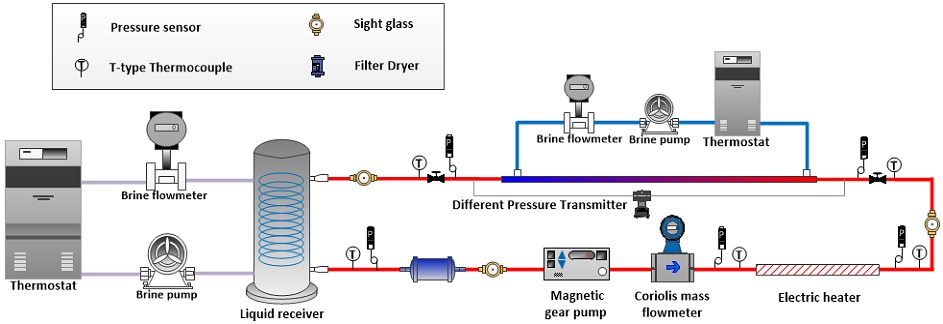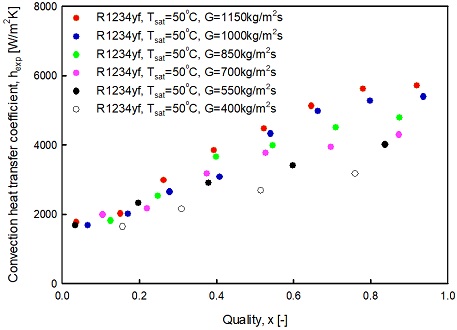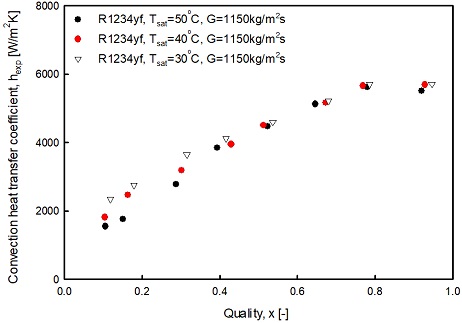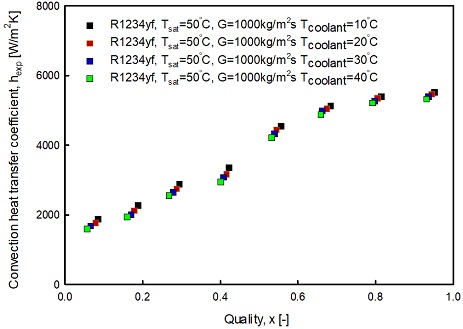
수평관 내 R-1234yf 응축 열전달 실험
 ; Joon-Hyuk Lee**
; Joon-Hyuk Lee** ; Jeong-In Yoon*
; Jeong-In Yoon* ; Sung-Hoon Seol*
; Sung-Hoon Seol* ; Eun-Min Park**
; Eun-Min Park** ; Sang-Woo Lee***, †
; Sang-Woo Lee***, †
Abstract
Due to environmental problems around the world, HFC refrigerants have been used instead of CFC and HCFC refrigerants with high ODP in the field. But, these refrigerants are also subject to regulation due to their high GWP. Accordingly to cope with the phased regulatory planning of HFC refrigerants, related companies have developed HFO refrigerants with low GWP. Among HFO refrigerants, the working fluid R-1234yf (GWP:4) in this paper is similar in thermodynamic properties to R-134a (GWP:1300). The experiment results are summarized as follows. The condensation heat transfer coefficient of R-1234yf in the double tube heat exchanger increased with increasing mass flux and quality. The condensation heat transfer coefficient decreased with increasing saturation temperature, but at high mass flux and high quality, it had little effect on saturation temperature. As the temperature difference between the coolant and the refrigerant increased, the heat transfer coefficient tended to increase. The condensation heat transfer coefficient of R-1234yf is lower than that of R-134a in almost all quality. However, at low quality and low mass flux the condensation heat transfer coefficient of R-1234yf tended to be greater than R-134a. Due to the difference in refrigerant physical properties such as density, surface tension, and thermal conductivity of the two refrigerants. As a result, it is believed that this paper could be used as a foundation for the optimal design of condensers using R-1234yf.
Keywords:
Condensation, Heat transfer coefficient, Double tube heat exchanger, R-1234yf, R-134a1. 서 론
전 세계적으로 환경문제가 대두되고 있어 냉동공조분야에서는 오존층 파괴 지수(ODP)가 높은 CFC(chlorofluorocarbons)계 냉매와 HCFC (hydrochloro-fluorocarbons)계 냉매를 대신해 HFC (Hydrofluorocarbon)계 냉매를 사용해 왔다. 하지만 이들 냉매는 지구온난화지수(GWP)가 높아 이 또한 규제대상이 되었다. HFC계 냉매의 단계적 규제 계획에 대처하기 위해 전 세계적으로 다양한 연구가 진행되고 있으며, 그 결과 차세대 냉매로 각광받고 있는 HFO계 냉매가 등장하였다. 해당 HFO계 냉매에 대한 연구는 다양하게 진행 중이고,1-9) 그 중 R-1234yf의 열전달특성에 관한 연구는 2000년대 들어 활발해져 다양한 논문들이 발표되었으며, 대표적인 종래연구는 다음과 같다.
Del Col 등1)은 내경 0.96 mm 관에서 R-1234yf의 응축 열전달계수를 측정하여 R-134a와 비교하였다. Wang 등2)은 R-1234yf의 응축 열전달실험에서 100~400 kg/m2s의 질량 유속, 포화온도 40~50℃에서 측정하였다. Yang 등3)은 수평관에서 R-1234yf 및 R-134a의 응축열전달에 대해 실험하였다.
이상의 종래연구 결과를 미루어 보았을 때 R-1234yf(GWP:4)는 R-134a(GWP:1300)와 열역학적 물성치가 비슷하다. 하지만 R-134a에 비해 성능이 미흡하므로 R-1234yf의 원활한 사용을 위해 열교환기 최적화 설계를 통하여 성능을 높일 수 있음을 판단할 수 있다. 따라서 R-134a와 R-1234yf의 열전달 특성 분석을 통해 최적의 열교환기 설계 기초 자료를 제공하는 것이 본 논문의 목적이다.
2. 실험장치 및 방법
2.1 장치도 설명
Fig. 1은 유체 냉각 방식의 응축 열전달 실험장치의 개략도이다. 실험장치는 크게 냉매 순환부, 물-에틸렌글리콜 순환부, 냉각수 순환부 세 부분으로 구성된다. 냉매 순환부는 기어펌프에서 냉매량을 조절하고 질량유량계를 지나 예열기에서 적정 건도를 맞추게 된다. 이때 약 3,000 mm 정도의 단열된 동관을 설치하여 냉매의 유동을 안정화 시킨 뒤 이중관 열교환기의 내관인 테스트 섹션에 들어가게 된다. 테스트 섹션을 나온 냉매는 수액기로 들어가고 물-에틸렌글리콜 순환부에서 냉매와 열교환하여 다시 과냉각 상태로 응축되어 반복 실험을 할 수 있게 설계하였다. 냉각수 순환부는 이중관 열교환기 내관과 외관 사이의 공간에 냉각수가 대향류로 흐르게 된다. 냉매를 응축시키고 다시 데워진 냉각수는 유량계, 펌프를 지나 항온조로 들어가게 되어 적정온도를 맞추고 다시 순환하게 된다. 실험 조건은 Table 1과 같다.
3. 데이터 정리
본 연구에서 사용된 R-1234yf의 열물성값은 NIST에서 개발한 냉매 물설 계산 프로그램인 REFPROP version 10.010)을 이용하였다. 응축 열전달특성을 파악하기 위해서 실험 데이터는 다음과 같은 계산식을 사용하였다. 응축 열전달특성을 분석하기 위해 이중관 열교환기에 흐르는 냉매의 현열은 식 (1), 잠열은 식 (2)로 계산하며 냉각수의 열량은 식 (3)으로 계산한다.
| (1) |
| (2) |
| (3) |
응축 열전달계수는 뉴턴의 냉각법칙을 기초로 한 식 (4)로 계산된다.
| (4) |
냉매의 건도는 다음의 식 (5)와 같이 계산할 수 있고, 시험부의 구간별 출구 건도는 식 (6)과 같이 계산한다.
| (5) |
| (6) |
4 실험결과 및 고찰
4.1 질량유속에 따른 열전달계수
Fig. 3은 냉매 포화온도 50℃로 일정하게 하고 질량 유속의 변화에 따른 R-1234yf의 응축 열전달계수를 나타낸 것이다. 그림에서 Y축은 응축 열전달계수를 나타내고 X축은 건도를 나타낸다. 일정한 포화온도에서 질량 유속이 증가할수록 응축 열전달계수는 증가하는 경향을 보인다. 이것은 질량 유속이 증가함에 따라 난류가 증가하여 응축 열전달계수가 증가한 것이다. 또한 높은 질량 유속에서 더욱 높은 열전달계수를 보였고, 질량유속에 따른 응축 열전달계수는 질량 유속에 비례하여 커지며 선형적으로 증가하는 모습을 보였다. 또한 Fig. 3에서 높은 건도 영역이 낮은 건도 영역보다 응축 열전달계수가 큰 경향을 보였다. 이것은 테스트 섹션 내의 냉매 건도가 증가함에 따라 난류가 증가하면서 환상류라는 유동이 발달하였기 때문이다. 이는 건도가 커질수록 최댓값을 가지는 것을 알 수 있다.
4.2 포화온도에 따른 열전달계수
Fig. 4는 질량유속 1150 kg/m2s에서 R-1234yf가 응축되는 동안 포화온도 변화에 따른 응축 열전달계수를 나타낸다. 응축 열전달계수는 모든 포화온도에서 건도가 증가함에 따라 증가하는 경향을 보이며 포화온도가 증가할수록 응축 열전달계수는 감소하는 경향을 보인다. 이것은 포화온도가 증가함에 따라 냉매의 열역학적 물성치에서 냉매액의 열전도율이 감소하게 되며, 액막의 열저항을 증가시켜 냉매의 응축 열전달계수를 증가시키게 된 것이다. 또한 냉매의 포화온도 증가는 식 (7)로 계산된다. 환산압력을 증가시키며, 이러한 변화는 식 (8) 마티넬리 변수와 큰 관련이 있다. 액상과 기상의 점성계수비, 밀도비를 나타내고 있다. 냉매의 환산압력이 커짐에 따라 냉매는 2상 유동의 특성을 잃게 되고, 단상 상태의 특성에 가까워지게 된다. 이로 인해 포화온도가 증가함에 따라 응축 열전달계수의 감소를 예상할 수 있다.
4.3 냉각수 온도에 따른 열전달계수
Fig. 5는 포화온도는 50℃이고 질량유속은 400 kg/m2s일 때 냉각수 온도에 따른 응축 열전달계수를 보여준다. 냉각수 온도가 낮아질수록 냉매와 냉각수의 온도차가 커지게 된다. 이는 냉매에서 냉각수로 열전달 및 열유속이 커지게 된다. Fig. 6은 포화온도 50℃, 질량 유속 1,000 kg/m2s일 때 냉각수 온도에 따른 응축 열전달계수를 나타낸다. 모든 건도에서 냉각수 온도가 감소함에 따라 응축 열전달계수가 커지는 것을 알 수 있다. 특히, 낮은 건도 영역에서 냉각수의 영향이 크게 나타나는데, 이는 난류의 영향이 감소하면서 온도차에 의한 열전달계수가 커짐을 알 수 있다. 그러나 Fig. 6에서 볼 수 있듯이 높은 질량 유속인 1,000 kg/m2s에서는 그 영향이 거의 없어짐을 알 수 있는데, 이는 질량 유속이 빨라지면서 강제 대류가 주요 열전달 메커니즘으로 작용하여 열 유속에 영향이 거의 사라지기 때문이다.
| (7) |
| (8) |

Comparison of R-1234yf condensation heat transfer coefficient according to coolant temperature with G=400 kg/m2s
5. 결 론
이중관 열교환기 내 R-1234yf의 응축 열전달계수는 질량유속과 건도가 증가함에 따라 증가하였다. 그러나 낮은 건도에서는 질량 유속의 영향이 거의 나타나지 않았다. 응축 열전달계수는 포화온도의 증가에 따라 감소하였으나 높은 질량 유속, 높은 건도에서는 포화온도의 영향이 거의 미치지 않았다. 또한 냉각수, 냉매의 온도 차가 커짐에 따라 열전달계수는 커지는 경향을 보였다. 하지만 높은 질량 유속에서는 그 차이가 미미하였다.
이러한 결과로 본 논문은 R-1234yf를 이용하는 응축기 최적 설계에 기초 자료로 활용할 수 있을 것이라고 판단된다.
― 기 호 설 명 ―
| CP : | Specific heat at constant pressure [kJ/kgK] |
| d : | Diameter [m] |
| G : | Mass flux [kg/m2s] |
| g : | Gravity acceleration [m/s2] |
| h : | Heat transfer coefficient [W/m2K] |
| i : | Enthalpy [kJ/kg] |
| k : | Thermal conductivity [kW/mK] |
| L : | Length [m] |
| Q : | Heat capacity [kW] |
| T : | Temperature [℃] |
| U : | Velocity [m/s] |
| x : | Quality |
| P : | Pressure [MPa] |
| Xtt : | Martinelli parameter |
그리스 문자
| ρ : | Density [kg/m3] |
| μ : | Dynamic Viscosity [kg/m·s] |
하첨자
| fg : | From liquid to gas |
| i : | Inner |
| in : | Inlet |
| L : | Liquid |
| o : | Outer |
| out : | Outlet |
| R : | Refrigerant |
| sub : | Subsection |
| LH : | Latent Heat |
| SH : | Sensible Heat |
| cl : | Coolant |
| tp : | Two phase |
| VO : | All mixture assumed to be vapor |
| v : | Vapor |
| w : | Wall |
| r : | Reduced |
| c : | Critical point |
Acknowledgments
‘이 논문은 부경대학교 자율창의학술연구비(2019년)에 의하여 연구되었음’, 본 연구는 ‘이상우’의 ‘4 mm 수평관 내 HFO-1234yf 응축열전달 및 압력강하’의 석사 논문의 일부입니다.
Author contributions
C. H. Son; Supervision. J. H. Lee; Data curation. J. I. Yoon; Investigation. S. H. Seol; Methodology. E. M. Park; Formal analysis. S. W. Lee; Project administration
References
-
D. Del Col, D. Torresin and A. Cavallini, 2010, "Heat transfer and pressure drop during condensation of the low GWP refrigerant R1234yf", International Journal of Refrigeration, Vol. 33, pp. 1307-1318.
[https://doi.org/10.1016/j.ijrefrig.2010.07.020]

-
L. Wang, C. Dang and E. Hihara, 2012, "Experimental study on condensation heat transfer and pressure drop of low GWP refrigerant HFO1234yf in a horizontal tube", International Journal of Refrigeration, Vol. 35, pp. 1418-1429.
[https://doi.org/10.1016/j.ijrefrig.2012.04.006]

-
C. Y. Yang and H. Nalbandian, 2018, "Condensation heat transfer and pressure drop of refrigerants HFO-1234yf and HFC-134a in a small circular tube", International Journal of Heat and Mass Transfer, Vol. 127, pp. 218-227.
[https://doi.org/10.1016/j.ijheatmasstransfer.2018.07.093]

-
G. A. Longo, A. Mancin, G. Righetti and C. Zilio, 2017, "Saturated vaper condensation of HFC404A inside a 4mm ID horizontal smooth tube - Comparison with the long term low GWP substitutes HC290(Propane) and HC1270(Propylene)", International Journal of Heat and Mass Transfer, Vol. 108, pp. 2088-2099.
[https://doi.org/10.1016/j.ijheatmasstransfer.2016.12.087]

-
Q. Guo, M. Li and H. Gu, 2018, "Condensation heat transfer characteristics of low-GWP refrigerants in a smooth horizontal mini tube", International Journal of Heat and Mass Transfer, Vol. 126, pp. 26-38.
[https://doi.org/10.1016/j.ijheatmasstransfer.2018.05.034]

-
M. Hirose, J. Ichinose and N. Inoue, 2018, "Development of the general correlation for condensation heat transfer and pressure drop inside horizontal 4 mm small diameter smooth and microfin tubes", International Journal of Refrigeration, Vol. 90, pp. 238-248.
[https://doi.org/10.1016/j.ijrefrig.2018.04.014]

-
G. A. Longo, S. Mancin, G. Righetti and Z. Zilio, 2018, "Saturated vapor condensation of R410A inside a 4mm ID horizontal smooth tube - Comparison with the low GWP substitute R32", International Journal of Heat and Mass Transfer, Vol. 125, pp. 702-709.
[https://doi.org/10.1016/j.ijheatmasstransfer.2018.04.109]

-
G. A. Longo, S. Mancin, G. Righetti and C. Zilio, 2019, "Saturated vapour condensation of R134a inside a 4 mm ID horizontal smooth tube Comparison with the low GWP substitutes R152a, R1234yf and R1234ze(E)", International Journal of Heat and Mass Transfer, Vol. 133, pp. 461-473.
[https://doi.org/10.1016/j.ijheatmasstransfer.2018.12.115]

-
S. T. Lee, H. J. Kim and H. S. Lee "The Performance Analysis of Sea Water Heat Pump applied Low GWP Refrigerants", Journal of Power System Engineering, Vol. 20, No. 5, pp. 92-97.
[https://doi.org/10.9726/kspse.2016.20.5.092]

- E. W. Lemmon, I. H. Bell, M. L. Huber and M. O. McLinden, 2018, "NIST Standard Reference Database 23: Reference Fluid Thermodynamic and Transport Properties- REFPROP Version 10.0", National Institute of Standards and Technology, Standard Reference Data Program, Gaithersburg.





